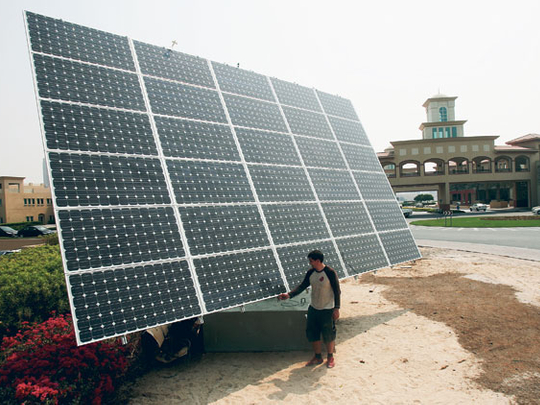
The Middle East has tremendous potential in solar and wind energy, and is confronted with daunting water and waste problems, but no Arab company was present at the Cleantech Forum in Paris at the end of last month, and that's a real pity.
The UAE's renewable energy giant Masdar had a large commercial presence in San Francisco last February, but in Paris, it was China and India that dominated the interest of this high-level forum on energy ‘eco-efficiency'.
As ever, the challenge is about how to provide for rapidly growing populations while diminishing the impact on the environment; how to provide infrastructure and housing for sprawling urbanisation projects while using sustainable materials.
For the first time in history, said Cleantech co-founder and executive chairman Nicolas Parker, there are more people in cities than in rural areas; and this is the largest human population the world has ever hosted. In Mumbai alone, over a million Indians head for the city each day!
India has also created a National Clean Energy Fund, imposing a coal levy or carbon tax generating some $550 million (Dh2.01 billion) per year. HSBC Executive Director Nick Robins referred to South Korea's very ambitious and committed ‘Green New Deal'.
In China, some 70,000 engineers are trained each year, according to Parker, who also said that there are about 2,000 clean tech start-up companies now, plus over 300 more a year, approximately a $10 billion market, dominated by Asia.
With this "metabolic rate of change", Parker is not alone in viewing Asia — and China in particular — as the centre of the "innovation revolution". Paul Kloppenborg, Global Cleantech Capital CEO, said that China's dominance in the photovoltaic (PV) market would effectually bring prices down for "green infrastructure" around the world.
Global venture capital investment in solar energy decreased by 60 per cent in 2009, but this is not a demand driven market; supply of PV panels is twice as much as demand. Robert Markus Feldman from Deloitte said this over-supply is good for consumers since prices will be pushed down, and added that "the sun gives competitive advantage …"
The trick now is to optimise the sun's energy. Besides the race to build cheaper and always more PV panels, one extremely innovative answer proposed by Dr Feng Hsu from Space Energy is to obtain Space-Based Solar Power (SBSP) by placing satellites around the earth to reflect sunrays down to earth in more intensive waves to receiving areas, which would feed into a power grid.
According to Dr Hsu, Japan has adopted the search for space energy as part of its government policy. China is also including the concept in its national policy. Interest in the US was torpedoed back in the 1970s by the nuclear lobby when the Opec oil crisis erupted, but Nasa and the US Department of Defence have carried out many studies since and created the "space security office".
Another fascinating project was presented by Statkraft, Europe's largest renewable energy company based in Norway. In a nutshell: osmosis is a natural phenomenon whereby water goes through a semi-permeable membrane. This is how plants absorb and retain moisture. When fresh water meets salt water — when a river runs into a sea — enormous amounts of energy are released, which can be used to generate much more.
Statkraft opened the world's first osmotic power plant at Tofte outside Oslo in November 2009. The fresh water and salt water go into different chambers divided by an artificial membrane. The salt molecules in the sea water pull the freshwater through the membrane, increasing pressure, up a 120-metre water column, creating a waterfall effect, and powering energy.
Other interesting projects were also presented: Agrogeneration proposes using GPS tracking to detect nitrate density in soil to help tractors with agriculture products; and Novacem's new way of not releasing carbon emissions by using magnesium minerals rather than burning off carbon from limestone calcium — as cement is usually made.
There is tremendous potential here for the Middle East with the need for sustainable development as construction ripples continuously across the region.
Masdar City was mentioned in passing, but Arab companies were entirely absent. Energy is now very politically charged since it addresses the future of humanity. As we wait to see if the International Renewable Energy Agency (Irena), headquartered in Abu Dhabi, can deliver, renewables remain at less than 1 per cent of global energy supplies.
The transition will have to be very attractive and sooner rather than later for the world to follow.
- Stuart Reigeluth is editor of Revolve.










